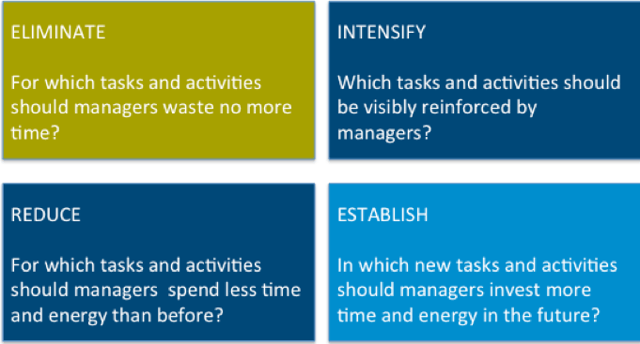From disinterested to engaged employees
Many talk about it, some are doing it already, others seem to have a hard time with it - how does potential development work in the end? Among decision-makers and HR officers this subject is at the top of the agenda. No wonder - it concerns nothing less but the success of the organisation. If we can make full use of human potentials, business booms. We have already pointed out this key success factor (KSF) in different places (article of 11-15-14, article of 06-20-14).
The two INSEAD professors W. Chan Kim and R. Mauborgne - known to most for their “Blue Ocean Strategy“ - published an interesting approach not too long ago (HBM June 2014). In essence it is about the following: In a 4-step-process managers of an enterprise develop target leadership profiles, that shall conform with requirements that have an optimal effect for the goal realisation of its respective employees, and thus for the total company success. The process is oriented on the classical pattern:
- Status analysis: A work group consisting of high-rank, recognized managers analyses by means of surveys, how employees experience leaders on the lower, middle and upper management level. The focus is on the main activities depending on the frequency of the behaviour of the executives, such as e.g. “Frequently demands detailed reports“. The results provide interesting indications. In one company e.g. it became obvious that the medium management spent much time protecting itself and controlling the observance of rules among others.
- Developing alternative profiles: In the next step the employees are again questioned regarding “cold spots“ (much time - little effect) and “hot spots“ (little time/neglected - big effect). The results are then put in a pattern, see illustration (p. 26). Which tasks of the executives shall be eliminated, reduced, intensified or established regarding the success of the company?
- Selecting leadership profiles: The leadership profiles that were created in that way are compared, questioned and evaluated regarding their practicability and effectiveness. From this process the new future leadership profiles evolve.
- Institutionalising practices: The last step is to establish the new procedure company-wide and to firmly anchor it.

From our point of view this procedure offers a good possibility of actually releasing potential in the company. Executives demonstrate behaviour patterns that are positive for the company success and that do not primarily serve their own interests. At best energies are released and everyone does what brings the most benefit. The advantage over contemporary procedures such as e.g. competency-based 360° feedbacks is that behaviour patterns that sometimes do not have much to do with everyday company life (and company success) are neglected and the focus is only on those relevant main tasks. However, questions also arise: The differentiation of the main tasks is purely based on the management level (upper, middle, lower). From our point of view this is no adequate differentiation, since the leadership work of a controller can be totally different from that of a manager in sales. In order to avoid this fault, specific leadership profiles could be established according to function. This would make things much more time-consuming.
A solution could be that one performs a KSF analysis (an analysis of the key success factors) before doing step 1. This is a method that we favour as a standard in our consulting processes. The KSF analysis can be relatively quickly performed in workshops according to the respective functional unit (controlling, sales etc.). In that way one obtains the key success factors of an enterprise according to function. These can then be compared with the theoretical activities determined in step 2 and be brought in accordance with them. By means of this effective procedure one obtains leadership profiles whose effectiveness has been tested according to function and management level and that represent differentiated, optimal target profiles.

